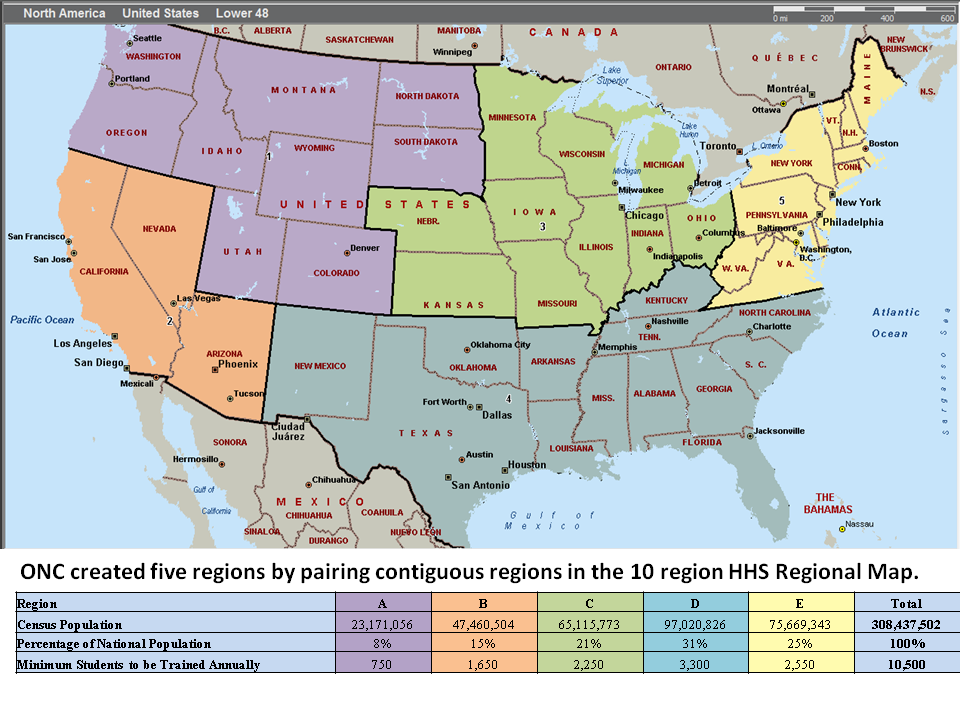CMS Second Annual Multi-State Health IT Collaborative for E-Health Conference
February 8–9, 2010: Agenda and Presentations Posted
Washington, DC
This Centers for Medicare & Medicaid Services (CMS) conference focused on federal-state collaboration on the HITECH rollout of electronic health records and health information exchange, and how Medicare and Medicaid Health IT programs and other ONC initiatives worked together. News, agenda, and the 20 presentations are posted below.
According to HIMSS News of February 12, 2010, 35 states had summitted State Medicaid HIT Plans for to receive planning funds for the Medicaid portion of the EHR Incentive Program. As HIMSS News explained “Plans are required to include the current HIT landscape in the state, the State’s Five-Year Vision for incorporating multiple resources (HIEs, Medicaid resources, local and state-wide resources, etc.), and the State’s vision for Oversight and Implementation.” As of March 24, 2010, 32 state (or territory) Medicaid programs had been awarded a total of $50 million for the 90/10 Medicaid Admin program. (See e-Healthcare Marketing post for table of states and amounts awarded.)
e-Healthcare Marketing has excerpted and posted the full agenda for the two-day conference and the 20 presentations, all of which appeared useful in more fully understanding the role of CMS and the states.
“CMS Second Annual Conference Site”: Materials
Program Agenda for both days in pdf format.
PROGRAM AGENDA–DAY ONE
Monday, February 8, 2010 (pdf version for Day One)
Welcome Remarks
This welcome session will highlight the importance of States in E-Health and will preview many of the health information technology (HIT) discussions planned throughout the conference, including priorities and lessons learned about promoting Electronic Health Record (EHR)/Health Information Technology adoption and key implementation issues for the Medicaid EHR Incentive Programs.
–Teresa Niño, Director, Office of External Affairs, Centers for Medicare & Medicaid Services (CMS)
–Cynthia Mann, Director, Center for Medicaid and State Operations, CMS
Concurrent Sessions I
Establishing Health Information Exchange Governance*
*(As a result of last-minute agenda changes, this session was combined with Health Information Technology and Exchange Planning.)
This session will provide guidance and tips on the different models of HIE governance that States could consider and the impacts/considerations for each.
Co-Moderators:
–Julie Alberino, Technical Director Region II, CMS
–Lee Stevens, Regional Manager, Office of the National Coordinator for Health Information Technology (ONC)
Speaker:
–Anthony Rodgers, Principal, Health Management Associates
Health Information Technology and Exchange Planning
(As a result of last-minute agenda changes, this session was combined with Establishing Health Information Exchange Governance.)
This session will outline important steps and considerations when planning for HIT/E projects, including legal issues, stakeholder involvement, existing infrastructure, and how CMS 90/10 FFP can be applied to the different models.
Speakers:
–Kelly Cronin, Director, Office of Programs and Coordination, ONC
–Denise Bazemore, Technical Director for State Systems, Center for Medicaid and State Operations, CMS
–Denise Webb, State Health IT Coordinator, Wisconsin Department of Health Services
–Jonah Frohlich, Deputy Secretary of Health Information Technology, California Health and Human Services Agency
Role of Managed Care in Health Information Technology and Exchange
This session will outline how Medicaid Managed Care Organizations can facilitate and support HIT/EHR promotion and the success of the Medicaid EHR Incentive Programs.
Moderator:
–Michelle Mills, Policy Analyst, Center for Medicaid and State Operations, CMS
Speakers:
–Dr. Kenneth Yale, Executive Director, AmeriChoice
–Lawrence Clark, SMHP Director, Pennsylvania Medicaid
Health Information Exchange Financing
This session will focus on the parameters of the CMS 90/10 administrative matching funds for statewide HIEs, ONC HIE’s funding, and will also present sustainable HIE financing from other sources.
Speakers:
–Rick Friedman, Director, Division of State Systems, Center for Medicaid and State Operations, CMS
–Mat Kendall, Acting Director of the Office of Provider Adoption Support, ONC
–Jack Shafer, West Virginia Primary Care Network
The CMS HITECH Proposed Rule
This session will offer the Federal perspective on the Medicaidrelated portions of the NPRM, CMS expectations, and what areas States need to focus on in the short term. Participants will be encouraged to ask questions of the CMS panel members, who will do their best to answer, with the caveat that the rule is proposed, not final.
Moderator/Speaker:
–Rick Friedman, Director, Division of State Systems, Centers for Medicaid and State Operations, CMS
Panel:
–Jessica Kahn, Technical Director for HIT, Center for Medicaid and State Operations, CMS
–Donna Schmidt, Technical Director for Quality, Evaluation & Health Outcomes, Center for Medicaid and State Operations, CMS
–Michelle Mills, Health Policy Analyst, Center for Medicaid and State Operations, CMS
–Judith Haron, Attorney, Office of General Counsel, U.S. Department of Health & Human Services
Office Hours: Talk With the Experts
These smaller, informal sessions are for you to ask the experts questions on HITECH implementation. These roundtable sessions are designed to be interactive. Please sign up in advance when you register onsite.
A. CMS 90/10 Financing for HITECH Implementation
Experts:
–Denise Bazemore, Technical Director, CMS
–Rick Friedman, Director, Center for Medicaid and State Operations, CMS
Pose questions about possible uses of the CMS 90/10 Administrative funding. Note that CMS will discuss our guiding principles for use of this funding, but answers are not in lieu of an approved P-APD or IAPD.
B. Technical Assistance Resources for State Agencies
Experts:
–Sherry Armstead, Technical Director, CMS
–Erin Grace, Senior Manager of HIT, Agency for Healthcare Research and Quality
–Mark Yanick, Public Health Analyst, Health Resources and Services Administration
Ask questions and receive detailed responses about the currently available and soon-to-be available federally funded technical assistance resources for State Agencies.
C. MMIS/MITA and HIT Integration
Experts:
–Dr. James Figge, Medical Director, New York State Department of Health
How do MITA and HITECH intersect? Ask a CMS and State representative how the MITA framework can be successfully applied to your State’s expanding HIT/E activities.
D. Approved CMS P-APDs & First Steps
Experts:
Lawrence Clark, SMHP Director, Pennsylvania Medicaid
Hear from other States that have approved HITECH P-APDs and ask about first steps, planning methodologies, how they hope to coordinate with their ONC HIE cooperative agreements, etc.
E. CMS Expectations for State Medicaid HIT Plans
Experts:
–Julie Alberino, Technical Director, CMS
–Jessica Kahn, Technical Director for HIT, CMS
–Michelle Mills, Health Policy Analyst, CMS
–Donna Schmidt, Technical Director for Quality, Evaluation & Health Outcomes, Center for Medicaid and State Operations, CMS
Talk to your CMS colleagues about the expected contents of State Medicaid HIT Plans. Ask questions about revamping older plans, starting from scratch, and/or how the Medicaid plans intersect with the ONC HIE plans.
Promoting Electronic Health Records Adoption/ Communications/ Outreach
This session will focus on strategies to encourage EHR adoption, and communication and outreach about the EHR efforts and identify effective messaging and roles for States.
–Christina Nye, Division Director, Florida Agency for Health Care Administration
–David Collins, Healthcare Information and Management Systems Society
–Mat Kendall, ONC
DAY TWO AGENDA
February 9, 2010 (pdf Version)
The Word From ONC: Health Information Technology and Health Care Transformation
Moderator:
–Alan Weil, Executive Director, National Academy for State Health Policy
Speaker:
–Dr. David Blumenthal, National Coordinator for Health IT, ONC
Maximizing Federal Health Information Technology and Exchange Funding
This session will focus on available Federal resources for HIT/E to States and how to best leverage them to achieve broad HIT/EHR adoption and achieve the goals of the HITECH Act. Speakers will identify for States the funding available for the different components of HIT/E development and maintenance.
Moderator:
–Patricia MacTaggart, Lead Research Scientist, George Washington University
Speakers:
–Kelly Cronin, Director, Office of Programs and Coordination, ONC
–Rick Friedman, Director, Division of State Systems, Center for Medicaid and State Operations, CMS
–Susan Lumsden, Director, Division of State and Community Assistance, Office of Health Information Technology, Health Resources and Services Administration
CONCURRENT SESSIONS II
Lessons Learned and Best Practices for Medicaid Health Information Technology Promotion
This session will highlight critical lessons learned and 20/20 hindsight from State Medicaid Agencies who have been working on HIT/EHR adoption projects.
Moderator:
–Jessica Kahn, Technical Director for HIT, Center for Medicaid and State Operations, CMS
Speakers:
–Dr. James Figge, Medical Director, New York State Department of Health
–Kim Davis-Allen, Alabama Medicaid
–Anthony Rodgers, Principal, Health Management Associates
Provider Readiness—Large, Small, and Solo Practices
This session will focus on challenges to HIT/EHR adoption facing providers in various practice sizes and how to best tailor your State’s approach to each as you implement the EHR Incentive Program.
Moderator:
–Nikki Highsmith, Senior Vice President for Programs, Center for Health Care Strategies
Speakers:
–Dr. Jonathan White, Health IT Director, Agency for Healthcare Research and Quality
–Dr. Sarah Chouinard, Medical Director, Community Health Network of West Virginia
–Dr. Farzad Mostashari, Senior Advisor to the National Coordinator, ONC
CONCURRENT SESSIONS III
CMS Draft Guiding Principles for Use of the 90/10 Administration Funds
After approval of the HIT P-APD and the State Medicaid HIT Plan (SMHP), State Medicaid Agencies will focus next on the activities necessary for implementing their EHR Incentive Program. This session will highlight key issues concerning implementation and offer an opportunity for Q&As from the audience.
Speakers:
–Rick Friedman, Director, Division of State Systems, Center for Medicaid and State Operations, CMS
–Jessica Kahn, Technical Director for HIT, Center for Medicaid and State Operations, CMS
–Michelle Mills, Health Policy Analyst, Center for Medicaid and State Operations, CMS
Medicaid Management Information Systems (MMIS) and Health Information Technology Integration and Coordination
This session will provide insight into the role of States’ MMIS systems and MITA as well as the future of HIT/E efforts in light of States’ implementation of the Medicaid EHR Incentive Program.
Moderator:
–Denise Bazemore, Technical Director for State Systems, CMS
Speakers:
–Robert Guenther, Technical Director for MITA, CMS
–Dr. James Figge, Medical Director, New York State Department of Health
–Carol Robinson, HIT Coordinator, State of Oregon
Harmonization of Privacy and Security for Health Information Exchange
This session will focus on how States could assess and address overlapping privacy and security issues related to HIE as they pertain to Federal and State laws, and beneficiary perceptions.
Moderator:
–Joy Pritts, J.D., Research Associate/Professor, Health Policy Institute, Georgetown University (since meeting moved to Chief Privacy Offficer, ONC)
Speaker:
–LaRah Payne, Senior Policy Analyst/Privacy Officer, District of Columbia Medicaid
Presentations in pdf format
The final conference presentations (20) are available for download and viewing in PDF format on the CMS Conference site.
Links to the 20 presentations in PDF format are also available below.



